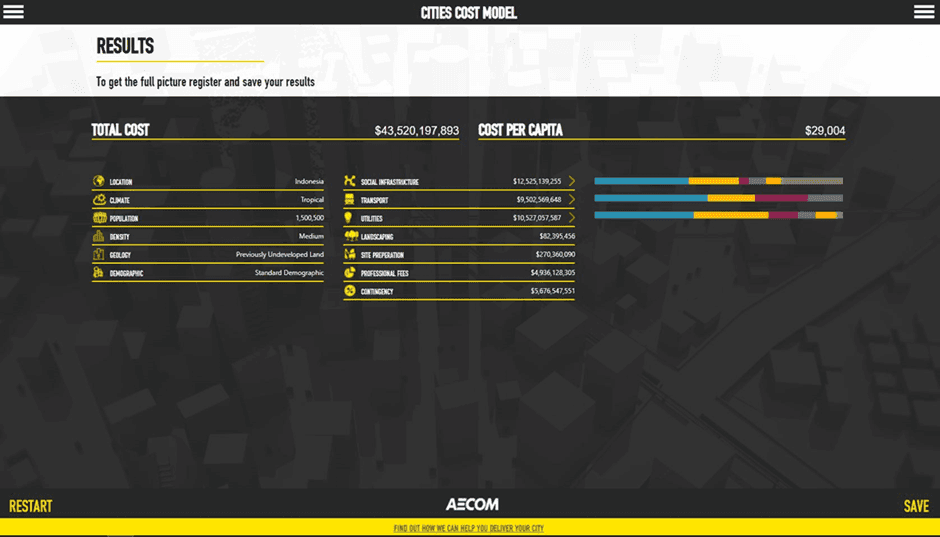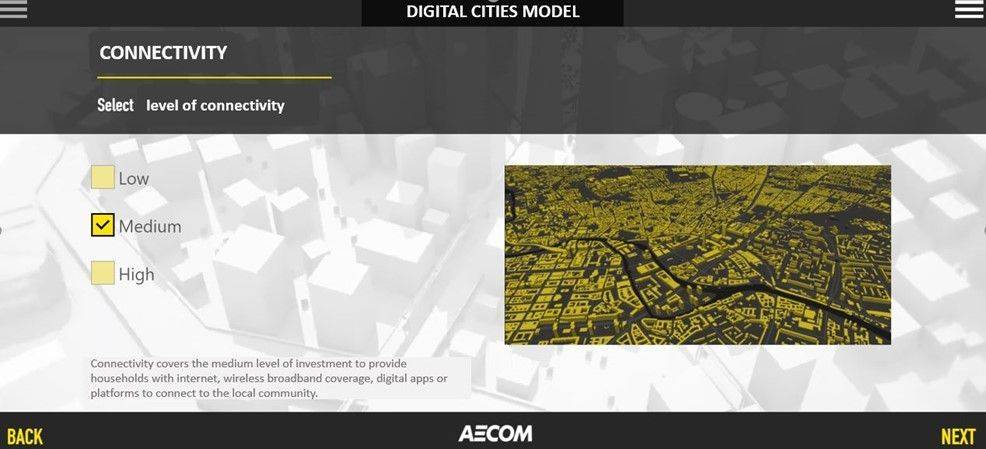
The Global Cities Cost Model: a bespoke approach


In order to position livability as a key outcome for the success of a digital city, there needs to be appropriate indicators in place to allow measurement of the relative effectiveness of digital city investments and how they impact people-centered outcomes.
To inform decision makers in the field of digital cities, we are therefore developing a Digital Cities Cost Model (DCCM), based on our Global Cities Cost Model, which provides key outputs on investment and their impact on outcomes.
The Global Cities Cost Model
The AECOM Global Cities Cost Model (GCCM) is an interactive tool that was developed in 2018 and showcases an integrated approach to the successful planning of new cities. It provides high-level data on infrastructure investment at a city scale on populations up to two million, and then considers the impact that different scenarios, including varying density, site conditions and demographics, has on the level of investment.
The GCCM assembles data by considering multiple scenarios, and uses linear regression model techniques and statistical reliability testing to generate outputs on infrastructure investment. Importantly, the model visualizes both the investment needs and the people-driven outcomes to help the user understand the link between the two, and the related impact of incremental increases or decreases in investment.
Figure 8 below is an example of the output for a hypothetical exercise undertaken to consider the infrastructure investment for a major new city on greenfield land in Indonesia, with a population of approximately 1.5 million.

Without the benefit of the GCCM, an exercise to calculate infrastructure investment of this scale would typically involve a significant team of advisors in a study lasting several months. However, using the GCCM model, subject to a series of caveats on the outputs, can not only generate an output in a significantly reduced timescale but can also allow for live sensitivity testing of the results in respect of the scenarios mentioned above.
Utilizing the GCCM for digital cities
The principles of the GCCM have then been used to create a Digital Cities Cost Model (DCCM), which visualizes the impact that investment in digital city measures will ultimately have on people-driven outcomes. An essential feature of this is that the model created is supported by a detailed database in relation to both investment and outputs. As such, the user will be able to generate these outputs by selecting options on investment rather than having to generate the data themselves.
Purpose of the DCCM
The overall aim of the DCCM is to make the invisible visible by deconstructing the complexity of the link between investment and outputs, which therefore facilitates the decision-making process and optimizes capital investment. Through measuring the people-based outcomes of well-being, inclusion, sustainability and resilience, it informs the user on the degree to which investment improves these outcomes. This will also help digital city technology providers to see the relative impact of their solutions, and empower digital city research and innovation.
Benefits of the DCCM
The DCCM provides transparency in the link between investment and outcomes through an interactive and easy-to-use tool.
The features of the DCCM
The key features of the DCCM utilizes the details in the December 2020 OECD Report on Measuring Smart Cities Performance, namely:
a. Select the location of the city in question.
b. Consider if this is a new or existing city. For an existing city, assess the degree to which smart city principles have already been adopted.
c. Identify the areas of investment related to:
- Connectivity
- Mobility
- Jobs and firms
- Housing and built environment
- Health and safety
- Education and skills
- E-government
- Energy, water and waste For each of the above, the model calculates where investment can be focused and agrees on a baseline for each. For example, connectivity will cover the investment needed to provide households with Internet, wireless broadband coverage, digital apps or platforms to connect to the local community. The model will then allow the user to calculate the level of investment, noting that the ultimate impact of this investment in terms of people-based outcomes will already be built into the model through the database.
In Figure 9 below, there are three levels of investment on connectivity covering low, medium and high, and we define the meaning of each of these within the model.

d. Identify the people-based outcomes related to well-being, inclusion, sustainability and resilience.
Again, for each of these, there will then be a series of outcomes to demonstrate the impact of the investment. For example, with well-being there will be details related to employment covering employment rate (%) and the number of people satisfied with their job (%). In Figure 10, the results of employment rate and job satisfaction are measured against the selected level of investment.

e. The final part of the DCCM covers the context of the outcomes in terms of other comparable cities. This will provide the benchmark against which each of the outcomes can be measured so that the user can assess where the outcome sits in terms of a range of below average to best in class.
Managing investment to drive outcomes
The DCCM, as with the GCCM, and subject to a series of caveats on the outputs, can not only generate an output in a significantly reduced timescale but it can also allow for live sensitivity testing of the results.
This can therefore help manage capital investment across a project, while at the same time maintain focus on livability outcomes. Through this, the DCCM can ensure investments are tied to a people-centred approach to digital city development.